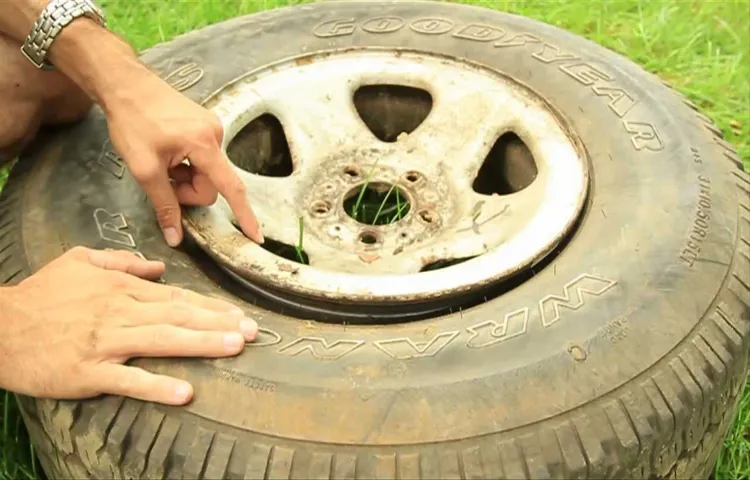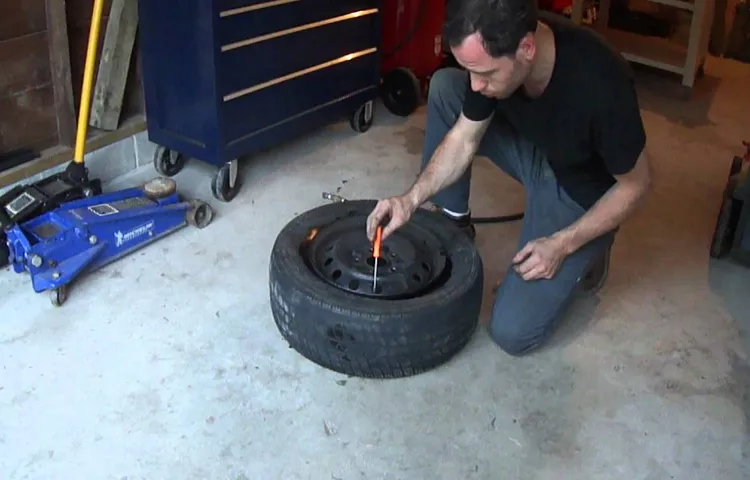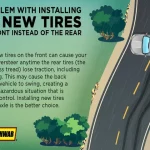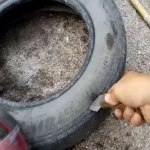Are you tired of replacing your tires every so often? Properly setting the tire bead can significantly increase the lifespan of your tires. However, it can be a daunting task for most people. Don’t worry, we’ve got you covered! In this guide, we’ll take you through the steps to ensure that the tire bead is set correctly.
It’s important to note that the process may vary depending on the type of tire and rim you’re working with. By the end of this blog, you’ll have all the information you need to successfully set your tire bead and enjoy long-lasting tires. So let’s get started!
Introduction
Setting tire bead can be a daunting task but with the right tools and techniques, it can be done easily. Before proceeding with the actual process, make sure that the tire is properly inflated, and the rim is clean and free from any burs or rust. Starting at the valve stem, make sure that the tire bead fits securely into the rim.
To set the bead, apply a bead sealer or lubricant to the tire bead and the rim flange. Then, place the tire on the rim and use a tire mounting machine or a manual tire changer to push the tire bead over the flange. As the tire bead pops onto the rim, you will hear a loud pop.
Ensure that both the top and bottom beads are seated evenly and inflate the tire to the manufacturer’s recommended pressure. In summary, following these simple steps can help set the tire bead quickly and efficiently.
What is a Tire Bead?
A tire bead might sound like something you wear around your wrist, but in reality, it’s a crucial component of your vehicle’s tire. The bead is the part of the tire that hugs the rim, creating an airtight seal that keeps the tire properly inflated. It consists of high-strength steel wires that are wrapped tightly together and coated in rubber to protect them from rust and wear.
Think of it like a belt buckle – just as a belt needs a sturdy buckle to keep it secure and in place, a tire needs a strong bead to stay firmly attached to the rim. Without a properly functioning bead, your tire won’t hold air and your vehicle won’t be able to move. So next time you take a look at your tires, give a little thanks to those hardworking beads!

Why is Setting a Tire Bead Important?
Setting a tire bead is an essential part of tire maintenance that many car owners overlook. It is the process of ensuring that the tire is firmly attached to the wheel’s rim and doesn’t come off while driving. You might be wondering, why is setting a tire bead important? Well, it’s because a tire that isn’t securely attached to the wheel can cause significant problems.
For instance, it can make the steering unstable, cause vibrations, and reduce traction, leading to an increased risk of accidents. That’s why it’s crucial to ensure that the tire bead is set correctly using proper tools such as a tire changer and a bead seater. Doing so will give you peace of mind while driving, knowing that your car’s tires are secured to the wheel and safe.
Step-by-Step Guide
Setting tire beads can be a daunting task, but with the right approach and tools, it can be done easily and quickly. Here is a step-by-step guide on how to set tire beads. First, ensure that the tire is properly mounted on the rim and the valve stem is in the correct position.
Next, lubricate the bead of the tire with a tire lubricant to reduce friction. Then, install the tire inflator tool onto the valve stem and start inflating the tire slowly. As the tire inflates, use a rubber mallet to tap the sidewalls of the tire to help it seat onto the rim.
Continue inflating the tire until you hear a loud pop, indicating that the bead has set. Lastly, check the tire pressure and adjust it accordingly. By following these steps, you’ll be able to set tire beads with ease and ensure a smooth and safe ride.
Prepare the Wheel and Tire
Preparing your wheel and tire before installation is an essential step that should not be overlooked. The first step is to ensure that the tire and wheel match, including the size and type of tire, and the diameter of the wheel. If they are not compatible, it can cause serious problems while driving, and it may cause damage to your vehicle.
Once you have verified compatibility, remove any dirt or debris from both the wheel and tire. This will ensure that the tire fits snugly onto the rim, which will provide better stability and performance. Afterward, prepare the wheel by cleaning it thoroughly with a wire brush or wheel cleaner.
This will remove any dirt or rust that may have accumulated and prepare the surface for the tire. A clean wheel will also make it easier to install the tire and provide a better seal. Make sure to inspect your tire and wheel for any damage before installation, as any issues will need to be addressed before installation.
Remember to always prioritize safety when performing any maintenance on your vehicle. With these simple steps, you can prepare your wheel and tire for a safe and smooth ride.
Apply Lubricant
To ensure smooth operation and longevity of your mechanical devices, it is essential that you apply lubricant regularly. Lubricants help reduce friction and prevent wear and tear on the moving parts of your machines. Here is a step-by-step guide on how to apply lubricant to your devices.
First, identify the parts of your device that require lubrication. This can be done by referring to the user manual or by observing the motion of the device. Once you have identified the parts, clean them thoroughly to remove any dirt or debris.
Next, select the appropriate lubricant for your device. Different devices require different types of lubricants, so make sure you choose the right one for your machine. Apply the lubricant generously to the moving parts of your device.
Be careful not to apply too much, as this can lead to the accumulation of grease and cause problems in the future. After applying the lubricant, operate your device for a few minutes to allow the lubricant to spread evenly across all the moving parts. Check the device for any excess lubricant and wipe it off with a clean cloth if necessary.
Remember to reapply the lubricant regularly, as it will wear off over time. By following these simple steps, you can ensure that your mechanical devices remain in good working condition and last longer. Don’t wait until your device starts to show signs of wear and tear before applying lubricant.
Regular lubrication can prevent costly repairs and prolong the life of your machines. So, take the necessary steps today and keep your machines running smoothly for years to come!
Align the Tire and Rim
When it comes to aligning a tire and rim, there are a few key steps to take in order to ensure a smooth and safe ride. Firstly, place the tire onto the rim and make sure the valve stem is in the correct position. Then, begin tightening the bolts, alternating between each one to ensure even pressure.
Use a torque wrench to ensure the bolts are tightened to the manufacturer’s specifications. Once the bolts are tightened, check the alignment by spinning the tire and watching for any wobbles or wiggles. If everything looks good, pump up the tire to the recommended pressure and you’re good to go.
It’s important to make sure to double check the alignment and pressure periodically to ensure the safety and longevity of your tires. So, remember to align your tire and rim properly to get the best ride possible!
Inflate the Tire
Inflating your car tire is something that should be done regularly to avoid any unexpected blowouts or flats. It may seem like a daunting task, but with the right tools and a little bit of knowledge, it’s a quick and easy DIY project. Here’s a step-by-step guide on how to correctly inflate your tire:
First, check the recommended pressure for your tire. This information can be found in your car manual, on the tire, or on a sticker located inside the driver’s side door. It’s essential to know the right pressure to ensure the tire’s optimal performance.
Unscrew the valve cap on the tire and attach the air chuck to the valve. Make sure it’s properly secured and won’t release any air during the inflation process.
Turn on the air compressor and fill the tire to the recommended pressure. Pay attention to the pressure gauge and don’t overinflate the tire, as it may cause damage.
Once the tire is at the correct pressure, remove the air chuck and replace the valve cap. Inflating your tire may seem like a small task, but it’s essential for your safety and the performance of your vehicle.
A well-inflated tire can also improve gas mileage, tire life, and handling. So next time you’re at the gas station, take a few extra minutes to check and inflate your tires properly.
Check for Leaks
Checking for leaks is a crucial step in maintaining any household or business property. Not only can leaks cause extensive damage, but they can also lead to higher water bills and a decrease in overall water pressure. The good news is that checking for leaks is a relatively simple process that you can do yourself.
First, turn off all faucets and appliances that use water and shut off the main water valve. Next, check your water meter to see if it continues to run. If it does, there is likely a leak somewhere in the system.
You can then check each toilet, faucet, and water-using appliance individually to determine the source of the leak. Don’t forget to check outdoor faucets and irrigation systems as well. By checking for leaks regularly, you can save money and prevent costly damage to your property.
Tips and Tricks
Setting a tire bead can be a difficult and intimidating process for those who have never attempted it before. The first step is ensuring that your tire is properly seated on the rim. Begin by applying lubricant to the bead of the tire, and then place the tire onto the rim.
Using a tire lever or your hands, work the bead over the rim, being careful not to pinch the inner tube. Once the tire is fully seated, it’s time to inflate it. Pump the tire up until it’s firm but not fully inflated, and then give it a hard slap on both sides.
This will help to seat the tire evenly onto the rim. Finally, inflate the tire to the recommended pressure, and give it a spin to ensure that it’s rolling smoothly. With these tips and tricks, you’ll be able to set your tire bead with ease and confidence.
Use a Bead Seater
If you’re looking for a quick and easy way to seat your tire beads, a bead seater is the solution you’ve been searching for. These handy tools use a blast of high-pressure air to force the tire bead onto the rim, creating a tight seal that prevents air leakage and ensures a smooth and comfortable ride. But before you get started, there are a few tips and tricks you should know to make the process as easy and effective as possible.
First, be sure to use a high-quality bead seater that’s designed to handle your particular tire size and style. Second, position the tool evenly around the rim and inflate the tire slowly and steadily to ensure the bead is evenly seated. Finally, give the tire a quick spin and check for any leaks or uneven spots before hitting the road.
By following these simple steps and using a reliable bead seater, you’ll be able to keep your tires in top condition and enjoy a safer, smoother ride every time you hit the road.
Use a Compressor with a High CFM Rating
If you’re in the market for a compressor that delivers high performance, you need to pay attention to the CFM rating. CFM stands for cubic feet per minute, and it refers to the volume of air that the compressor can deliver in one minute. Compressors with high CFM ratings are great for powering air tools that require a lot of air volume.
For instance, if you are a carpenter or mechanic, you need an air compressor with a high CFM rating to handle the air tools you use on a daily basis. However, be careful not to confuse this with PSI (pounds per square inch), which refers to the air pressure. The CFM rating is a lot more important for air tools.
If you’re looking for a compressor that strikes the perfect balance between CFM and PSI, you should check out the Dewalt D55168 200 PSI 15-Gallon Portable Air Compressor. It’s popular with contractors and DIY enthusiasts, thanks to its 0 CFM at 90 PSI, making it ideal for heavy-duty air tools.
Try the Zip Tie Trick
Are you tired of your zipper getting stuck or opening unexpectedly? Try the Zip Tie Trick! This simple hack can save you from embarrassing moments and frustrating situations. All you need to do is grab a small zip tie, loop it through the little hole in the zipper, and then attach it to the zipper pull. This creates a stopper that prevents the zipper from opening beyond the desired point, giving you peace of mind when you’re out and about.
Plus, it’s easy to remove when you’re ready to unzip your garment. So next time your zipper is giving you trouble, give the Zip Tie Trick a try – it’s a game-changer!
Conclusion
In conclusion, setting a tire bead requires patience, perseverance, and maybe a little bit of luck. But, armed with the right tools, techniques, and a dash of know-how, you can become a master of the tire bead. Just remember to take your time, apply the proper amount of force and lubrication, and always keep safety in mind.
After all, a properly seated tire bead is key to a smooth ride and an uneventful journey. So go forth, intrepid tire mounter, and conquer the bead with your tire-slaying skills!”
FAQs
What is setting a tire bead?
Setting a tire bead refers to the process of securing the tire onto the wheel’s rim.
What are the common methods for setting a tire bead?
The most common methods for setting a tire bead are using a bead blaster, a manual tire bead setter tool, or by using a propane torch.
Can I set a tire bead without a tool or equipment?
Yes, there are some DIY methods available to set a tire bead without any specialized tool or equipment, such as using dish soap and water, or using a ratchet strap.
What are the safety precautions for setting a tire bead?
When setting a tire bead, it is essential to wear eye protection, gloves, and to ensure you’re working in a well-ventilated area.
Can setting a tire bead damage my tire or rim?
Yes, if not done correctly, setting a tire bead can damage the tire or rim. It’s important to follow the recommended procedure and safety guidelines.
How do I know if the tire bead is properly set?
You can test the tire bead by spraying soapy water around the tire to look for any air bubbles, or by checking the air pressure in the tire.
What should I do if I can’t set the tire bead myself?
If you’re unable to set the tire bead yourself, it’s recommended to seek assistance from a professional tire service center or mechanic.



